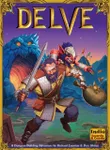DarkStar (2011)
Temps de jeu: 120
Age min.: 14
Joueurs: 2 - 4
Editeur: Print & Play Productions, (Web published)
Concepteurs: Klaude Thomas
Artistes: Ilya Baranovsky
Mécaniques: Area Movement, Variable Player Powers, Area Majority / Influence, Rock-Paper-Scissors
Age min.: 14
Joueurs: 2 - 4
Editeur: Print & Play Productions, (Web published)
Concepteurs: Klaude Thomas
Artistes: Ilya Baranovsky
Mécaniques: Area Movement, Variable Player Powers, Area Majority / Influence, Rock-Paper-Scissors
Afficher la description Afficher les commentaires Tendance des prix
Set thousands of years in the future, the board game DarkStar is based on classics such as Dune, Cosmic Encounter, and Diplomacy.
Strategically, DarkStar plays out something like Chess, although the game mechanisms are wildly different. Your key pieces are squadrons that you move around the board in stacks. The board itself being gridded into systems (where resources are located) and subsectors (empty space). Squadrons move from square-to-square on the board as in Chess. As the game proceeds, stargates twist space so that squares change their position relative to one another.
Another big difference from Chess is that conflicts are resolved using tactical core cards that will feel to you more like rock-paper-scissors. Unlike in Chess, attacking pieces won't always win. Furthermore you will get free moves and other kinds of special actions through playing Imperial edict cards.
The most destructive force in the game are antimatter missiles. You build missiles in stages on your systems and launch them during your turn. These missiles are the reason why the goal of the game — collecting three different deep-defense codes — is so important. Missile detonations destroy everything in a square and even burn up the square itself so that nothing can enter it. Owning three colors of deep-defense codes makes some of your squares immune to antimatter detonations, upsetting the balance of power and giving you a chance to win.
Strategically, DarkStar plays out something like Chess, although the game mechanisms are wildly different. Your key pieces are squadrons that you move around the board in stacks. The board itself being gridded into systems (where resources are located) and subsectors (empty space). Squadrons move from square-to-square on the board as in Chess. As the game proceeds, stargates twist space so that squares change their position relative to one another.
Another big difference from Chess is that conflicts are resolved using tactical core cards that will feel to you more like rock-paper-scissors. Unlike in Chess, attacking pieces won't always win. Furthermore you will get free moves and other kinds of special actions through playing Imperial edict cards.
The most destructive force in the game are antimatter missiles. You build missiles in stages on your systems and launch them during your turn. These missiles are the reason why the goal of the game — collecting three different deep-defense codes — is so important. Missile detonations destroy everything in a square and even burn up the square itself so that nothing can enter it. Owning three colors of deep-defense codes makes some of your squares immune to antimatter detonations, upsetting the balance of power and giving you a chance to win.
Nous n'avons actuellement aucune donnée de prix pour ce jeu.
Ce jeu n'est actuellement pas échangé sur la place de marché:
Ce jeu n'est actuellement pas listé sur la place de marché. Si vous voulez vendre le vôtre, veuillez l'ajouter à la place de marché.
Place de marché
Le jeu a également été publié sous ces noms:
DarkStar
Jeux liés
ag.gameitem.lastUpdated: 2025-05-15 15:24:46.827
















